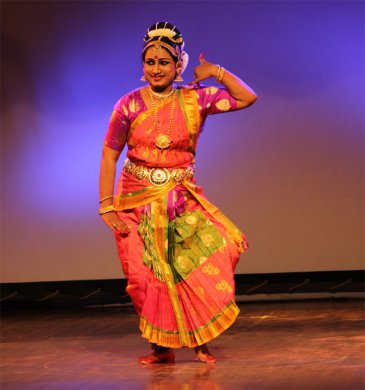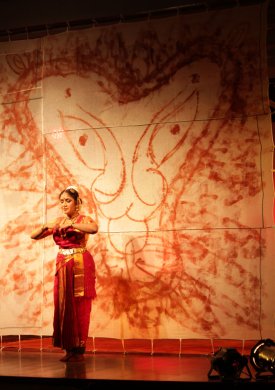
|   |

|   |
Kuchipudi in Karnataka - Ashish Mohan Khokar e-mail: khokar1960@gmail.com May 27, 2014 Karnataka boasts of its own mellam tradition - the Yakshagana – thus the advent of Kuchipudi, another mellam tradition, is not surprising. Many like Manju Barggavee, Veena Murthy Vijay and Vyjayanti Kashi, have contributed to its enrichment and outreach in the last few decades. Yet, there are not so many Kuchipudi dancers the city or state can boast of. Bharatanatyam (BN) remains numero uno. Everywhere, except in Odisha or Andhra, oops Seemandhra and Telangana now, BN rules. I learnt BN from a Kuchipudi guru Krishna Kumar, brother of veteran guru Narasimhachari. For long, I did not know if I was learning BN or Kuchipudi. As one Punjabi dancer from Jamshedpur once confided, "Ashish, when I do fast BN in Bihar, many think it is Kuchipudi!" The situation was compounded by many first gen stars of the form who did both BN and Kuchipudi - Yamini Krishnamurthi, Indrani Rahman, Ritha Devi. My first public performance (if it can be called that, for there were only 5 in the audience!) took place at great guru Vempati Chinna Satyam's rented school in T. Nagar, Madras, on Jan 7, 1975. But the five in the audience were equal to 500. There was guru Vempati himself, Dr. Raghavan (Nandini Ramani's father), my father Mohan Khokar, the handsomest Kuchipudi dancer Kamadeva and my shy mother M.K. Saroja. It was an impromptu show. Dr. Raghavan asked me to show what I had learnt in Kathak under Guru Kundan Lal Gangani. I did some 20 minutes of performance and they all clapped politely. That was my first and last show. The opinion was unanimous: I should leave dancing alone! Or at least not inflict on others. Our generation listened to hints and learnt from good, even unsaid, advice! Eyes spoke all. Ishara kaafi hota tha. Fast forward to 2014. Full 40 years later, I see a new energy the young people have. They are busy mounting events and fests and are multi-tasking. One such doer-dancer is Deepa Sashindran, who learnt Kuchipudi under many but is now primarily Manju Barggavee’s shishya. She also looks like her now. This shows complete merging with the art and guru. Deepa and her hubby Sashindran have set up the Kuchipudi Parampara Foundation just to promote Kuchipudi in Bangalore. The Natya Parampara Festival of 2 days (May 24 & 25) was their baby steps, though there was nothing childish about it. I could attend only day one and day two was not entirely about Kuchipudi. Bharatiya Vidya Bhavan’s Khincha Hall in Bangalore is centrally located (though like most metros, there is no center, each part of city is its own center) but a horrible hall to watch dance at. Seats are low, causing back pain: there is no padding, no gradation (slope) and the dwarfed angles of the stage is a sure show spoiler! The side centre door with comings and goings is a constant distraction for serious viewing on stage and on the whole the hall was never meant for dance as there is no stage height, wing space, etc. Add obstructive videographers who plonk their cameras with stand and all, bang in the centre of the hall and the bad picture in bad hall is complete. Organizers doing dance festivals should think about how audience suffers and gets to view it. Video recording can be done unobtrusively. Day one began almost on time and a spiffy film was shown on the guru being honoured - senior Pasumarthi Rattaiya Sharma. The fortunes of the form have grown but the fortune of most gurus remains pathetic. A survey done by Deepa herself (she is a sincere dancer, researcher and promoter) in the Kuchipudi village showed the condition of most gurus living in poverty. Is this how much we value our artistes, our culture? Where is Andhra pride and patronage? Why wait for central govt. and its agencies to dole out grants? Can't Andhra and now Telangana take care of its precious gurus and artists? Rama Devi (not former Governor of Karnataka but the dancer/writer), Dr. Deepak R.L. of the IRS, Churchill Pandian of Takka Dhimi Ta fame and Sashindran did the honours with yours truly and the two day focus and feast began. From Trichur came a lass trying to do Kuchipudi, without its qualifying flexion and form. In whatever she undertook there was a lack of punch so essential to the form. Eyes were blank, devoid of any involvement, although the body tried to show Kuchipudi which looked more like Bharatanatyam. Unless one maintains the postures, the lasya, the sauciness, the aplomb of the form, Kuchipudi done so can taste like food without salt. Her take-off on story of Mandodari based on Mandooka Sabdam (common fallacy to call it Shabdam with an offending H. Only one scholar - Dr. Pappu Venugopal Rao - uses it correctly) was detailed, again sans feeling. Conceptually too her second item depicting darshan of and at Tirumala was strange because when the poet sang and wrote about Tirumala and darshan, there were no long queues and curtains! Just 50/60 years ago those who went regularly to Tirumala have shared how simple and easy darshan at and of Lord of the Seven Hills (hence Sapthagiri) was. Annamacharya and Tyagaraja wrote several odes to several deities and contexts, not all can be merged with or used for depicting today's realities. THINK. Poetic license of an artiste has its limits. Deepa Sashindran thought well and developed a new angle, a new theme and danced next. Although over aharaya-ed and heavily costumed, she danced with softness and sense and Agnijyotsana - her ode to Draupadi - came through convincingly and with feeling. Excellently etched poses and pieces, despite a heavy frame, unfolded seamlessly, helped immensely by Sai Venkatesh's superb lights, which Ravi Vempati guided occasionally from the stage where he sat conducting. The team of musicians was simply superb, with each contributing significantly and enhancing the performances. Thanks to Sai Venkatesh, the orchestra too was well balanced; otherwise each member suffers from "increase my volume, increase mine" syndrome! Smitha Srinivasan is an accomplished Kathak dancer, mountaineer, and compere. Her voice is soothing and she conducts the proceedings with grace, clarity and dignity  Deepa Sashindran  Ananda Shankar Jayant Dr. Ananda Shankar Jayant next on stage came from Hyderabad bringing Kuchipudi from the soil. An accomplished BN dancer, she strove hard and did well in maintaining the quintessence oomph and personality of the style. Her two items, Tarangam and Simhanandini were detailed and well executed. Elaborate and evolutionary by definition, the choice of items proved cumbersome for the small stage and lack of proper facilities. This multi-tasker is also many other things besides being a dancer who survived cancer. There's only a difference of a single alphabet - C and D - between Cancer and Dancer but what a loaded and demanding difference. Ananda has stage presence, which few dancers have and this is one ingredient a dancer possesses or not. One can’t acquire it, learn it or buy it. Stage presence is god's special gift. Ananda is also a natural on stage. What she is, she is. As Guest Editor of the next issue of attendance, she was also there for its launch. Originally the issue was called Andhra Traditions and then Telangana happened, so keeping all sensibilities and sensitivities in mind (she also being an officer of the state) she had to redo the cover and content to include all Telugu Traditions, to be released soon when the dust of elections have settled down. In the meanwhile, she mounted a capsuled history of Kuchipudi and showcased well known exponents and gurus, stars and students, which too came alive on the set pages of the issue due shortly . Deepa Sashindran deserves kudos for mounting this ambitious and inclusive focus on the fine parampara that is Kuchipudi. Ashish Mohan Khokar is an internationally reputed dance critic and historian. He edits and publishes India’s only yearbook on dance – attendance - in its 16th year now. He is the inheritor- curator of India’s largest dance archives. He is India’s only dance biography publisher (Ekah). He mentors many young talents and helps mount special academic dance DISCourses. He Chairs the Dance History Society, which has instituted annual awards in memory of dance greats. For details see attendance-india.com |